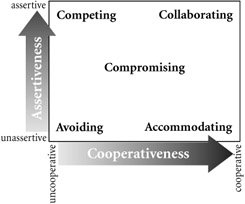Assessing Where You Stand
Assessing Where You Stand
The second baseline capability that is key to influencing others is an understanding of how you deal with conflict. This entails being crystal clear on where you stand in terms of the two personality dimensions of assertiveness and cooperativeness.
Assertiveness is the extent to which a person attempts to satisfy his or her own needs. We've already gone into considerable detail about the importance of knowing where your behavior falls on the continuum from nonassertive to assertive to aggressive . Cooperativeness is the extent to which an individual attempts to satisfy another person's needs. When you look at these two basic dimensions of behavior in conjunction with one another and assess the degree of balance that exists between the concern for oneself and for others, it becomes possible to identify five distinct methods that people employ when dealing with conflict.
The Thomas-Kilmann Conflict Mode Instrument [1] in Figure 5-2 is a graphic representation of these five methods.

Figure 5-2: The Thomas-Kilmann Conflict Mode Instrument.
Thomas and Kilmann define each method as follows :
-
Competing implies being assertive and uncooperative. An individual who chooses this method is more interested in pursuing his or her own concerns at the expense of others. This individual uses whatever power is necessary to win. When a person competes, he or she is defending a position at all costs.
-
Accommodating entails being unassertive and cooperative. This method, which is the opposite of competing, implies selfsacrifice. The accommodating individual chooses to neglect his or her own concerns to satisfy the concerns of others. This method requires giving in to another's point of view when you prefer not to.
-
Avoiding is being unassertive and uncooperative. An individual using this method merely chooses not to take action at this time, either for himself or herself or for others. As a result, the conflict is not addressed. The avoidance behavior might take the form of sidestepping the discussion of an issue, postponing it, or withdrawing from what the individual perceives to be a threatening situation.
-
Compromising involves being square in the middle in terms of both assertiveness and cooperativeness. This method is often expedient. Both parties seek to quickly arrive at some middle ground by splitting the difference, in a sense. The end result might be a solution that is mutually acceptable yet only partially satisfying to each side.
-
Collaborating means being both assertive and cooperative. Collaborating requires that both sides be willing to work together to find a solution that fully satisfies the concerns of each. It involves an in-depth exploration of differences to learn from each other's insights.
With these methods in mind, take a few moments to decide where on the model your workplace behavior generally falls. Then, think about the reaction this behavior provokes in others ”and the effect it has on your ability to work harmoniously with them:
-
Are you often kept in the dark because people would rather keep their opinions to themselves than deal with your hard-nosed attitude?
-
Would your colleagues respond more positively to your suggestions if you were less aggressive and more cooperative?
-
Are your needs frequently unmet , either because you cannot assert yourself or because you refuse to budge from your position?
-
Do you often feel like a doormat because you would rather accommodate others than assert yourself?
-
Do you usually seek a middle-of-the-road solution, a compromise, to put an end to dissension?
-
Are you able to assert yourself without appearing uncooperative? In other words, are you a collaborative individual, whom everyone wants on his or her team?
The answer to the last question in the sequence separates superior conflict managers from the rest of the lot. If your answer was yes, you are indeed rare. Few people are able, without training, to cooperate without giving in, to assert themselves without stepping on toes ”in short, to honor other people's needs without sacrificing their own.
The two baseline capabilities that we described are essential tools in all conflict situations. But every conflict situation in the workplace poses unique challenges and, therefore, requires situation-specific skills. Let's examine these skills in some detail.
[1] Adapted from Kenneth Thomas, "Conflict and Conflict Management," The Handbook of Industrial and Organizational Psychology , Marvin Dunnette, editor (Chicago: Rand McNally, 1976).
EAN: 2147483647
Pages: 99